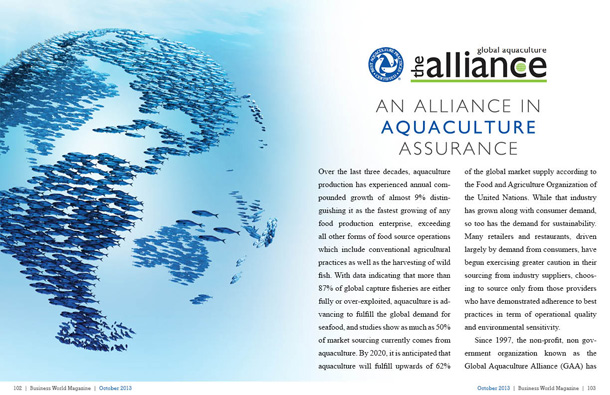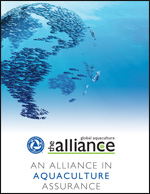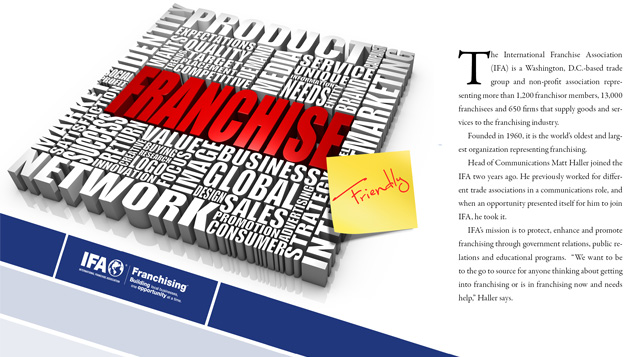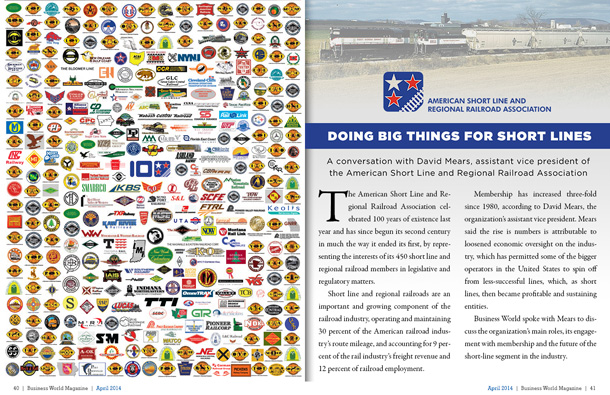
An Alliance in Aquaculture Assurance

Over the last three decades, aquaculture production has experienced annual compounded growth of almost 9% distinguishing it as the fastest growing of any food production enterprise, exceeding all other forms of food source operations which include conventional agricultural practices as well as the harvesting of wild fish. With data indicating that more than 87% of global capture fisheries are either fully or over-exploited, aquaculture is advancing to fulfill the global demand for seafood, and studies show as much as 50% of market sourcing currently comes from aquaculture. By 2020, it is anticipated that aquaculture will fulfill upwards of 62% of the global market supply according to the Food and Agriculture Organization of the United Nations. While that industry has grown along with consumer demand, so too has the demand for sustainability. Many retailers and restaurants have begun exercising greater caution in their sourcing from industry suppliers, choosing to source only from those providers who have demonstrated adherence to best practices in term of operational quality and environmental sensitivity.
Since 1997, the non-profit, non government organization known as the Global Aquaculture Alliance (GAA) has provided a means of distinguishing environmentally and socially responsible suppliers by developing the industry’s most comprehensive certification standards which reflect best aquaculture practices. An international alliance, headquartered in St. Louis, the mission of the Global Aquaculture Alliance is to further environmentally responsible aquaculture to meet world food needs.
Communications Manager Steven Hedlund says through GAA’s Best Aquaculture Practices third-party certification program, GAA encourages the use of responsible production systems that are sustainable in meeting environmental and community needs, as well as efficient in providing safe, wholesome aquaculture products to the world’s population. GAA also serves to help communicate the importance of aquaculture as a source of food and employment. It supports technological research and the exchange of vita information between its members and research facilities, advocates for the industry through regional and global initiatives, and helps promote effective, coordinated government regulatory and international trade policies.
Hedlund says other NGOs have been established over the years, but GAA has distinguished itself not only through the comprehensive nature of its standards for production, but through market incentives that prompt the genuine value in earning BAP certification. “We’ve created a market incentive for farmed-seafood producers to improve practices through a measurable, routinely updated set of standards that not only relate to environmental responsibility, but also food safety and animal welfare. We also don’t shy away from social responsibility. Our standards also involve worker rights and worker safety … we cover everything the market demands in this day and age,†says Hedlund.
Those standards have not only helped improve aquaculture operations, but have significantly allayed concerns of retailers and restaurants by providing what Hedlund calls “a differentiated product.†“The supplying of safe and sustainable seafood was once considered as something of a novelty, but it has increasingly becoming the norm. There are many restaurant chains and retailers which have enacted sustainable seafood sourcing policies. They want assurance, and any company which can’t demonstrate that they are adhering to safe and responsible practices are behind the 8-ball,†say Hedlund. In this case, the GAA has not only helped distinguish the best operators within a very competitive marketplace, it has also provided the means to achieve a certification that enables access to the market. Markets throughout the world are increasingly looking for the GAA label of certified approval.
The Certification Process
To participate in the Best Aquaculture Practices program, applicants are initially provided with criteria documents which allow for their own respective self-monitoring and review. When accepted, facilities undergo a site inspection by an independent, third-party auditor and present specified production records for traceability for at least three months. After successful inspection, facilities pay a program fee based on total annual seafood production volume. Farms that wish to participate in the BAP certification program may do so individually (with or without a sponsor), or they may be organized as part of a group of farms under the active assistance of a sponsoring organization. Integrated Operating Module (IOM) Farm Units are groups of medium to small-sized farms that have been organized under the sponsorship of a processor, farmer cooperative or association, or other legally recognized entity. Certification can be achieved in a range of processes as criteria has been customized for everything from finfish and crustacean farm standards, seafood processing/repacking plant standards, salmon farm standards, mussel farm standards, shrimp hatchery standards, feed mill standards and more. Hedlund says standards have evolved from 2003 when the GAA designed its first set of standards for shrimp farming. Today, the GAA has been critical in certifying some 600 aquaculture operations around the world, collectively representing more than 1.4 million metric tons of products annually supplied to markets in Asia, Europe and North America.
Hedlund expects demand for safe and sustainable sourcing to increase because demand for seafood is increasing. “Seafood consumption is seeing significant growth in Asia where the middle class is booming. As their economy increases, many consumers upgrade their diet and demand more seafood,†says Hedlund. “Studies have shown that there will soon be a need to annually supply an additional 40 metric tons of seafood for consumers by 2030, but wild fisheries can’t accommodate that growth, only aquaculture is capable of fulfilling that demand.â€
And to Hedlund’s point, as aquaculture moves to satiate the appetite of seafood lovers, the GAA will continue working to differentiate the providers that meet that demand through safe, socially and environmentally sensitive practices.
To learn more about the programs and research supported by the Global Aquaculture Alliance, as well as the Best Aquaculture Practices certification program, visit the Alliance’s website at www.gaalliance.org.







